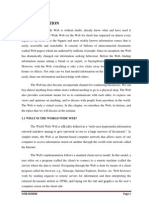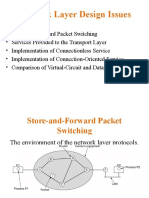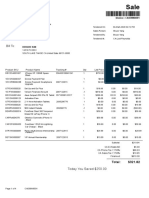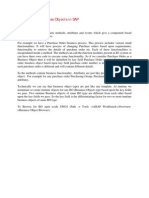Customer Churn Analysis - Jupyter Notebook
Customer Churn Analysis - Jupyter Notebook
Uploaded by
akash.050501Copyright:
Available Formats
Customer Churn Analysis - Jupyter Notebook
Customer Churn Analysis - Jupyter Notebook
Uploaded by
akash.050501Copyright
Available Formats
Share this document
Did you find this document useful?
Is this content inappropriate?
Copyright:
Available Formats
Customer Churn Analysis - Jupyter Notebook
Customer Churn Analysis - Jupyter Notebook
Uploaded by
akash.050501Copyright:
Available Formats
07/12/2023, 15:50 Customer Churn Analysis - Jupyter Notebook
Import necessary libraries
In [1]: 1 import pandas as pd
2 import numpy as np
3 import matplotlib.pyplot as plt
4 import seaborn as sns
Read dataset
In [2]: 1 df=pd.read_csv('Tel_Customer_Churn_Dataset.csv')
2 df.head()
Out[2]:
customerID gender SeniorCitizen Partner Dependents tenure PhoneService MultipleLines InternetService Onlin
7590- No phone
0 Female 0 Yes No 1 No DSL
VHVEG service
5575-
1 Male 0 No No 34 Yes No DSL
GNVDE
3668-
2 Male 0 No No 2 Yes No DSL
QPYBK
7795- No phone
3 Male 0 No No 45 No DSL
CFOCW service
9237-
4 Female 0 No No 2 Yes No Fiber optic
HQITU
5 rows × 21 columns
In [3]: 1 df.info()
<class 'pandas.core.frame.DataFrame'>
RangeIndex: 7043 entries, 0 to 7042
Data columns (total 21 columns):
# Column Non-Null Count Dtype
--- ------ -------------- -----
0 customerID 7043 non-null object
1 gender 7043 non-null object
2 SeniorCitizen 7043 non-null int64
3 Partner 7043 non-null object
4 Dependents 7043 non-null object
5 tenure 7043 non-null int64
6 PhoneService 7043 non-null object
7 MultipleLines 7043 non-null object
8 InternetService 7043 non-null object
9 OnlineSecurity 7043 non-null object
10 OnlineBackup 7043 non-null object
11 DeviceProtection 7043 non-null object
12 TechSupport 7043 non-null object
13 StreamingTV 7043 non-null object
14 StreamingMovies 7043 non-null object
15 Contract 7043 non-null object
16 PaperlessBilling 7043 non-null object
17 PaymentMethod 7043 non-null object
18 MonthlyCharges 7043 non-null float64
19 TotalCharges 7043 non-null object
20 Churn 7043 non-null object
dtypes: float64(1), int64(2), object(18)
memory usage: 1.1+ MB
Dropping unwanted columns
localhost:8888/notebooks/KINGS LABS/4. Customer churn analysis/Customer Churn Analysis.ipynb 1/10
07/12/2023, 15:50 Customer Churn Analysis - Jupyter Notebook
In [4]: 1 df=df.drop(["customerID"], axis = 1)
2 df.head()
Out[4]:
gender SeniorCitizen Partner Dependents tenure PhoneService MultipleLines InternetService OnlineSecurity On
No phone
0 Female 0 Yes No 1 No DSL No
service
1 Male 0 No No 34 Yes No DSL Yes
2 Male 0 No No 2 Yes No DSL Yes
No phone
3 Male 0 No No 45 No DSL Yes
service
4 Female 0 No No 2 Yes No Fiber optic No
Converting the 'TotalCharges' column to numeric values
In [5]: 1 df['TotalCharges'] = pd.to_numeric(df['TotalCharges'], errors='coerce')
2 df.info()
<class 'pandas.core.frame.DataFrame'>
RangeIndex: 7043 entries, 0 to 7042
Data columns (total 20 columns):
# Column Non-Null Count Dtype
--- ------ -------------- -----
0 gender 7043 non-null object
1 SeniorCitizen 7043 non-null int64
2 Partner 7043 non-null object
3 Dependents 7043 non-null object
4 tenure 7043 non-null int64
5 PhoneService 7043 non-null object
6 MultipleLines 7043 non-null object
7 InternetService 7043 non-null object
8 OnlineSecurity 7043 non-null object
9 OnlineBackup 7043 non-null object
10 DeviceProtection 7043 non-null object
11 TechSupport 7043 non-null object
12 StreamingTV 7043 non-null object
13 StreamingMovies 7043 non-null object
14 Contract 7043 non-null object
15 PaperlessBilling 7043 non-null object
16 PaymentMethod 7043 non-null object
17 MonthlyCharges 7043 non-null float64
18 TotalCharges 7032 non-null float64
19 Churn 7043 non-null object
dtypes: float64(2), int64(2), object(16)
memory usage: 1.1+ MB
Checking for null values
localhost:8888/notebooks/KINGS LABS/4. Customer churn analysis/Customer Churn Analysis.ipynb 2/10
07/12/2023, 15:50 Customer Churn Analysis - Jupyter Notebook
In [6]: 1 df.isnull().sum()
Out[6]: gender 0
SeniorCitizen 0
Partner 0
Dependents 0
tenure 0
PhoneService 0
MultipleLines 0
InternetService 0
OnlineSecurity 0
OnlineBackup 0
DeviceProtection 0
TechSupport 0
StreamingTV 0
StreamingMovies 0
Contract 0
PaperlessBilling 0
PaymentMethod 0
MonthlyCharges 0
TotalCharges 11
Churn 0
dtype: int64
Treating null values
In [7]: 1 df = df.dropna()
In [8]: 1 df.isnull().sum().sum()
Out[8]: 0
EDA
localhost:8888/notebooks/KINGS LABS/4. Customer churn analysis/Customer Churn Analysis.ipynb 3/10
07/12/2023, 15:50 Customer Churn Analysis - Jupyter Notebook
In [9]: 1 #churn distribution
2
3 plt.figure(figsize=(8, 6))
4 plt.bar(df['Churn'].unique(), df['Churn'].value_counts(), color=['green', 'yellow'])
5 plt.title('Churn Distribution', fontsize=16, fontweight='bold')
6 plt.xlabel('Churn')
7 plt.ylabel('Count')
8 plt.grid(axis='y', linestyle='--', alpha=0.7)
9 plt.show()
localhost:8888/notebooks/KINGS LABS/4. Customer churn analysis/Customer Churn Analysis.ipynb 4/10
07/12/2023, 15:50 Customer Churn Analysis - Jupyter Notebook
In [10]: 1 #churn vs gender
2
3 sns.countplot(x='gender', hue="Churn", data=df, palette=['green', 'yellow'], edgecolor = 'Bl
4 sns.despine()
5 plt.grid(axis='y', linestyle='--', alpha=0.7)
In [11]: 1 #churn vs SeniorCitizen
2
3 sns.countplot(x='SeniorCitizen', hue="Churn", data=df, palette=['green', 'yellow'], edgecolo
4 sns.despine()
5 plt.grid(axis='y', linestyle='--', alpha=0.7)
localhost:8888/notebooks/KINGS LABS/4. Customer churn analysis/Customer Churn Analysis.ipynb 5/10
07/12/2023, 15:50 Customer Churn Analysis - Jupyter Notebook
In [12]: 1 #churn vs partner
2
3 sns.countplot(x='Partner', hue="Churn", data=df, palette=['green', 'yellow'], edgecolor = 'B
4 sns.despine()
5 plt.grid(axis='y', linestyle='--', alpha=0.7)
In [13]: 1 #churn vs dependents
2
3 sns.countplot(x='Dependents', hue="Churn", data=df, palette=['green', 'yellow'], edgecolor =
4 sns.despine()
5 plt.grid(axis='y', linestyle='--', alpha=0.7)
localhost:8888/notebooks/KINGS LABS/4. Customer churn analysis/Customer Churn Analysis.ipynb 6/10
07/12/2023, 15:50 Customer Churn Analysis - Jupyter Notebook
In [14]: 1 #churn vs contract
2
3 sns.countplot(x='Contract', hue="Churn", data=df, palette=['green', 'yellow'], edgecolor =
4 sns.despine()
5 plt.grid(axis='y', linestyle='--', alpha=0.7)
In [15]: 1 #churn vs MonthlyCharges
2
3 ax = sns.kdeplot(df['MonthlyCharges'][df["Churn"] == 'No'], fill = True,color='green')
4 ax = sns.kdeplot(df['MonthlyCharges'][df["Churn"] == 'Yes'],ax =ax, fill= True,color='skyblu
5 ax.legend(["Not Churn","Churn"],loc='upper right')
6 ax.set_ylabel('Density')
7 ax.set_xlabel('Monthly Charges')
8 ax.set_title('Distribution of monthly charges by churn')
Out[15]: Text(0.5, 1.0, 'Distribution of monthly charges by churn')
localhost:8888/notebooks/KINGS LABS/4. Customer churn analysis/Customer Churn Analysis.ipynb 7/10
07/12/2023, 15:50 Customer Churn Analysis - Jupyter Notebook
In [16]: 1 #churn vs TotalCharges
2
3 ax = sns.kdeplot(df['TotalCharges'][df["Churn"] == 'No'], fill = True,color='green')
4 ax = sns.kdeplot(df['TotalCharges'][df["Churn"] == 'Yes'],ax =ax,fill= True,color='skyblue'
5 ax.legend(["Not Churn","Churn"],loc='upper right')
6 ax.set_ylabel('Density')
7 ax.set_xlabel('TotalCharges')
8 ax.set_title('Distribution of Total Charges by churn')
Out[16]: Text(0.5, 1.0, 'Distribution of Total Charges by churn')
Label encoding
In [17]: 1 df["gender"]=df["gender"].map({"Female":0,"Male":1})
2 df["Partner"]=df["Partner"].map({"No":0,"Yes":1})
3 df["Dependents"]=df["Dependents"].map({"No":0,"Yes":1})
4 df["PhoneService"]=df["PhoneService"].map({"No":0,"Yes":1})
5 df["PaperlessBilling"]=df["PaperlessBilling"].map({"No":0,"Yes":1})
6 df["Churn"]=df["Churn"].map({"No":0,"Yes":1})
In [18]: 1 df=pd.get_dummies(df,drop_first=True)
2 df.head()
Out[18]:
gender SeniorCitizen Partner Dependents tenure PhoneService PaperlessBilling MonthlyCharges TotalCharges
0 0 0 1 0 1 0 1 29.85 29.85
1 1 0 0 0 34 1 0 56.95 1889.50
2 1 0 0 0 2 1 1 53.85 108.15
3 1 0 0 0 45 0 0 42.30 1840.75
4 0 0 0 0 2 1 1 70.70 151.65
5 rows × 31 columns
Assigning dependent and independent variable
localhost:8888/notebooks/KINGS LABS/4. Customer churn analysis/Customer Churn Analysis.ipynb 8/10
07/12/2023, 15:50 Customer Churn Analysis - Jupyter Notebook
In [19]: 1 X=df.drop(columns = "Churn")
2 y=df["Churn"]
Machine Learning classification model libraries
In [20]: 1 from sklearn.linear_model import LogisticRegression
2 from sklearn.tree import DecisionTreeClassifier
3 from sklearn.ensemble import RandomForestClassifier
4 from sklearn import metrics
5 from sklearn.metrics import classification_report
6 from sklearn.model_selection import train_test_split
Splitting the dataset into training and testing set
In [21]: 1 X_train, X_test, y_train, y_test = train_test_split(X, y, test_size = 0.3, random_state =12
Logistic regression
In [22]: 1 logmodel = LogisticRegression(random_state=50)
2 logmodel.fit(X_train,y_train)
3 pred = logmodel.predict(X_test)
4
5 print(classification_report(y_test, pred))
precision recall f1-score support
0 0.85 0.88 0.87 1567
1 0.63 0.57 0.60 543
accuracy 0.80 2110
macro avg 0.74 0.73 0.73 2110
weighted avg 0.80 0.80 0.80 2110
C:\Users\msi\anaconda3\Lib\site-packages\sklearn\linear_model\_logistic.py:460: ConvergenceWar
ning: lbfgs failed to converge (status=1):
STOP: TOTAL NO. of ITERATIONS REACHED LIMIT.
Increase the number of iterations (max_iter) or scale the data as shown in:
https://scikit-learn.org/stable/modules/preprocessing.html (https://scikit-learn.org/stabl
e/modules/preprocessing.html)
Please also refer to the documentation for alternative solver options:
https://scikit-learn.org/stable/modules/linear_model.html#logistic-regression (https://sci
kit-learn.org/stable/modules/linear_model.html#logistic-regression)
n_iter_i = _check_optimize_result(
Decision Tree
localhost:8888/notebooks/KINGS LABS/4. Customer churn analysis/Customer Churn Analysis.ipynb 9/10
07/12/2023, 15:50 Customer Churn Analysis - Jupyter Notebook
In [23]: 1 dtmodel = DecisionTreeClassifier(criterion = "gini", random_state = 50)
2 dtmodel.fit(X_train, y_train)
3 dt_pred = dtmodel.predict(X_test)
4
5 print(classification_report(y_test, dt_pred))
precision recall f1-score support
0 0.83 0.79 0.81 1567
1 0.47 0.52 0.49 543
accuracy 0.72 2110
macro avg 0.65 0.66 0.65 2110
weighted avg 0.73 0.72 0.73 2110
Random Forest
In [24]: 1 rfmodel = RandomForestClassifier(n_estimators = 100, criterion = 'entropy', random_state = 0
2 rfmodel.fit(X_train, y_train)
3 rf_pred = rfmodel.predict(X_test)
4
5 print(classification_report(y_test, rf_pred))
precision recall f1-score support
0 0.84 0.89 0.86 1567
1 0.62 0.50 0.55 543
accuracy 0.79 2110
macro avg 0.73 0.69 0.71 2110
weighted avg 0.78 0.79 0.78 2110
In [25]: 1 # Factors contributing to customer attrition :
2 # 1. Contract - if it is 'Month to month', churn rate is high
3 # 2. Monthly charge - if it is between 65 and 110, churn rate is high
4 # 3. Total charg - churn rate is high when it is less than 2000
localhost:8888/notebooks/KINGS LABS/4. Customer churn analysis/Customer Churn Analysis.ipynb 10/10
You might also like
- FIT2001 Assignment3 Team63Document23 pagesFIT2001 Assignment3 Team63knprop134No ratings yet
- Deutz EMR2 Electronic Engine GovernorDocument60 pagesDeutz EMR2 Electronic Engine GovernorCláudio Lima89% (37)
- Dissertation On Leadership Style and Job SatisfactionDocument10 pagesDissertation On Leadership Style and Job SatisfactionHelpWithWritingPaperSingaporeNo ratings yet
- Dominos Winning StrategiesDocument185 pagesDominos Winning StrategiesY Ammar IsmailNo ratings yet
- Table of Contents - Computer NetworksDocument3 pagesTable of Contents - Computer NetworksJit Agg100% (1)
- Client Server Architecture A Complete Guide - 2020 EditionFrom EverandClient Server Architecture A Complete Guide - 2020 EditionNo ratings yet
- A New AISI Cold-Formed Steel Design ManualDocument7 pagesA New AISI Cold-Formed Steel Design ManualAkshay V PatilNo ratings yet
- (Case Study) Big Data, Big RewardsDocument2 pages(Case Study) Big Data, Big RewardsHoàng Hải Yến TrầnNo ratings yet
- Telecommunication Customer Churn (New)Document23 pagesTelecommunication Customer Churn (New)Ruchi Saini100% (1)
- Data Warehousing: Online Analytical Processing (OLAP)Document44 pagesData Warehousing: Online Analytical Processing (OLAP)sana faizNo ratings yet
- LAB-Final Assessment Test: InstructionsDocument7 pagesLAB-Final Assessment Test: InstructionsMajety S LskshmiNo ratings yet
- M.E. Bda 2021Document64 pagesM.E. Bda 2021Mohammad BilalNo ratings yet
- Networking Final AssessmentDocument21 pagesNetworking Final AssessmentDurodolaNo ratings yet
- NC600 - NC600W Use ManualDocument31 pagesNC600 - NC600W Use ManualGustavo Adolfo Sotomayor LagoNo ratings yet
- Chapter One (History and Overview)Document36 pagesChapter One (History and Overview)mesfinNo ratings yet
- Ch5 Retrieval Evaluation 2021Document26 pagesCh5 Retrieval Evaluation 2021Abdo AbaborNo ratings yet
- Data Structure Using 'C' Hashing: Department of CSE & IT C.V. Raman College of Engineering BhubaneswarDocument55 pagesData Structure Using 'C' Hashing: Department of CSE & IT C.V. Raman College of Engineering BhubaneswardeepakNo ratings yet
- Q 2-MIS-Set1Document3 pagesQ 2-MIS-Set1aatishphansekarNo ratings yet
- Web MiningDocument71 pagesWeb MiningNirav TrivediNo ratings yet
- Jimma University JIT School of Computing Advanced Database System LabDocument70 pagesJimma University JIT School of Computing Advanced Database System LabMuller Asha100% (1)
- Advanced Database Technology: Ambo UniversityDocument28 pagesAdvanced Database Technology: Ambo Universitymikeyas meseret100% (1)
- NPTEL Presentation For Orientation ProgramDocument23 pagesNPTEL Presentation For Orientation ProgramYogesh NeelappaNo ratings yet
- Operating System Module Only For Exit Exam Preparation DawitDocument29 pagesOperating System Module Only For Exit Exam Preparation DawitFuad EdrisNo ratings yet
- (Midterm Examination) Name: Permit No: Course: Section:: System Network AdministrationDocument4 pages(Midterm Examination) Name: Permit No: Course: Section:: System Network AdministrationRodrigo CalapanNo ratings yet
- Student Placement CellDocument123 pagesStudent Placement CellMayur prakash KambleNo ratings yet
- The Project Documentation of Telephone Billing SystemDocument78 pagesThe Project Documentation of Telephone Billing Systemdeep2550% (1)
- Lab 6 - Using MS VisioDocument7 pagesLab 6 - Using MS VisioHarpratap SinghNo ratings yet
- Project Title Tree Topology in Cisco Packet Tracer: Submitted ToDocument10 pagesProject Title Tree Topology in Cisco Packet Tracer: Submitted Tosaira rajputNo ratings yet
- Control System Engineer ResumeDocument6 pagesControl System Engineer ResumeMoeed IqbalNo ratings yet
- Unit 4Document47 pagesUnit 4A21126512117 SUKALA ABHIRAMNo ratings yet
- System Analysis and Design ProjectDocument5 pagesSystem Analysis and Design ProjectOkoro MonneyNo ratings yet
- Designing ProLogDocument17 pagesDesigning ProLogSatenaw Gojame Satenaw GojameNo ratings yet
- Network and System Administration CHP 1 & 2Document26 pagesNetwork and System Administration CHP 1 & 2Solomon TetekaNo ratings yet
- Use An Enterprise Information SystemDocument7 pagesUse An Enterprise Information SystemMarshalee WillisNo ratings yet
- Monitor and Support Data Conversion Abenet DBMS L IVDocument5 pagesMonitor and Support Data Conversion Abenet DBMS L IVAbenet AsmellashNo ratings yet
- Linker and LoaderDocument25 pagesLinker and LoaderKim AyeKpam100% (1)
- Network Design IssuesDocument13 pagesNetwork Design IssuesMohith VarmaNo ratings yet
- L9 SQLDocument128 pagesL9 SQLHariNo ratings yet
- ECE Course DescriptionDocument10 pagesECE Course Descriptionengshimaa100% (1)
- SE 7204 BIG Data Analysis Unit I FinalDocument66 pagesSE 7204 BIG Data Analysis Unit I FinalDr.A.R.KavithaNo ratings yet
- Computer Careers and CertificationDocument35 pagesComputer Careers and CertificationAngelina LimNo ratings yet
- Networking Mid-Semester Exam Marking Scheme - 2004-5 Semester 1Document7 pagesNetworking Mid-Semester Exam Marking Scheme - 2004-5 Semester 1abraha gebruNo ratings yet
- Unit3 CS8792 CNS Notes PECDocument26 pagesUnit3 CS8792 CNS Notes PECK ManeeshNo ratings yet
- Final ReportDocument27 pagesFinal ReportMihir DesaiNo ratings yet
- Chapter 1 Overview of OOPDocument154 pagesChapter 1 Overview of OOPJason RuizNo ratings yet
- Chapter 1 PDFDocument43 pagesChapter 1 PDFKavya ParasharNo ratings yet
- Comprehensive 1 PDFDocument154 pagesComprehensive 1 PDFSrinithy SaravananNo ratings yet
- Java IEEE Final Year Project Titles 2022 2023Document2 pagesJava IEEE Final Year Project Titles 2022 2023Yash patilNo ratings yet
- 07 Huawei Industrial IoT GatewaysDocument36 pages07 Huawei Industrial IoT GatewaysMehdiYahyaNo ratings yet
- CCS335-Cloud-Computing-QB - Unit 3, 4 & 5Document57 pagesCCS335-Cloud-Computing-QB - Unit 3, 4 & 5vishnupriya1662004No ratings yet
- Use Case DiagramDocument24 pagesUse Case DiagramkashishNo ratings yet
- Test1 - SECJ1013 - 20192020 - 01Document16 pagesTest1 - SECJ1013 - 20192020 - 01Yusra HatimNo ratings yet
- Data Base CompleteDocument75 pagesData Base CompleteJawad AhmadNo ratings yet
- Learning Guide # 4: LO 4: Connect Workstation To The InternetDocument17 pagesLearning Guide # 4: LO 4: Connect Workstation To The InternetAlage TekaNo ratings yet
- Module 2 - Lecture 3 - Network Configuration - LAN SetupDocument28 pagesModule 2 - Lecture 3 - Network Configuration - LAN SetupZeeshan BhattiNo ratings yet
- MIT146 - Course SyllabusDocument2 pagesMIT146 - Course SyllabusFurqan Ali KhanNo ratings yet
- Health Care Chat Bot System Using Artificial IntelligenceDocument6 pagesHealth Care Chat Bot System Using Artificial IntelligenceALNATRON GROUPSNo ratings yet
- 3.business Processes in IotDocument6 pages3.business Processes in Iotmanoj.professorcseNo ratings yet
- Atm Management System: Object Oriented Software EngineeringDocument5 pagesAtm Management System: Object Oriented Software EngineeringWasim JafarNo ratings yet
- Communication Hardware & Communication SoftwareDocument16 pagesCommunication Hardware & Communication SoftwareDigs ObrienNo ratings yet
- E Commerce Notes PDF Lecture Notes University LevelDocument64 pagesE Commerce Notes PDF Lecture Notes University LevelAbhishek aggarwalNo ratings yet
- Network Management System A Complete Guide - 2020 EditionFrom EverandNetwork Management System A Complete Guide - 2020 EditionRating: 5 out of 5 stars5/5 (1)
- 04ts36 Back DoorDocument6 pages04ts36 Back DooralejandroNo ratings yet
- Resume Chawla+Document1 pageResume Chawla+Akash JhaNo ratings yet
- Unit-4 TocDocument14 pagesUnit-4 TocAnonymous yGN2aqyMNo ratings yet
- TISAX Handbook ENDocument117 pagesTISAX Handbook ENlesdy madai hernandez hernandezNo ratings yet
- Chapter 4 - Software DesignDocument42 pagesChapter 4 - Software DesignshimelisNo ratings yet
- ANGULAR 8 Interview QuestionsDocument50 pagesANGULAR 8 Interview Questionsking4u9No ratings yet
- Solved Exercises ch08Document4 pagesSolved Exercises ch08sadiaNo ratings yet
- Osi Model (Open System Interconnection)Document33 pagesOsi Model (Open System Interconnection)Chandan Srivastava100% (1)
- S21 User Guide Version FDocument56 pagesS21 User Guide Version Flo4okNo ratings yet
- What Is The Fastest Broadband Internet Service in MalaysiaDocument44 pagesWhat Is The Fastest Broadband Internet Service in MalaysiaTimothy LimNo ratings yet
- Catalog - 2008 AMP NetconnectDocument340 pagesCatalog - 2008 AMP NetconnectPipercommNo ratings yet
- WebUI Users GuideDocument143 pagesWebUI Users GuidebachankNo ratings yet
- Version Control SystemDocument4 pagesVersion Control SystembharathimanianNo ratings yet
- 3.0 A, 15 V, Step-Down Switching Regulator: IL2576-xxDocument10 pages3.0 A, 15 V, Step-Down Switching Regulator: IL2576-xxscribesquemasNo ratings yet
- Nyenrode MBA CV Book 2015Document100 pagesNyenrode MBA CV Book 2015k_m_4000No ratings yet
- An Overview of 3D Printing Technologies For Food FabricationDocument11 pagesAn Overview of 3D Printing Technologies For Food Fabricationpostasului54No ratings yet
- How To Trigger A Sales Order Idoc ORDERS05Document12 pagesHow To Trigger A Sales Order Idoc ORDERS05Ramesh Balaji100% (1)
- SBE11 CH 09 ADocument23 pagesSBE11 CH 09 AUJJWALNo ratings yet
- Intel® RAID Basic Troubleshooting Guide: Technical Summary DocumentDocument16 pagesIntel® RAID Basic Troubleshooting Guide: Technical Summary DocumentdenilsonluisNo ratings yet
- Are Ironic Acts Deliberate?Document12 pagesAre Ironic Acts Deliberate?Diana0% (1)
- Victra Usa XR 128GBDocument1 pageVictra Usa XR 128GBDupe EliseNo ratings yet
- Hotel Opening ChecklistDocument61 pagesHotel Opening ChecklistDouglas KingNo ratings yet
- Electrocraft BLDC CatalogDocument49 pagesElectrocraft BLDC CatalogElectromateNo ratings yet
- VEH-MB-ML320-ESP-W163 ESP Part1 PDFDocument14 pagesVEH-MB-ML320-ESP-W163 ESP Part1 PDFd9dNo ratings yet
- Working With Business Objects in SAPDocument17 pagesWorking With Business Objects in SAPkmurth_hnNo ratings yet

























































































